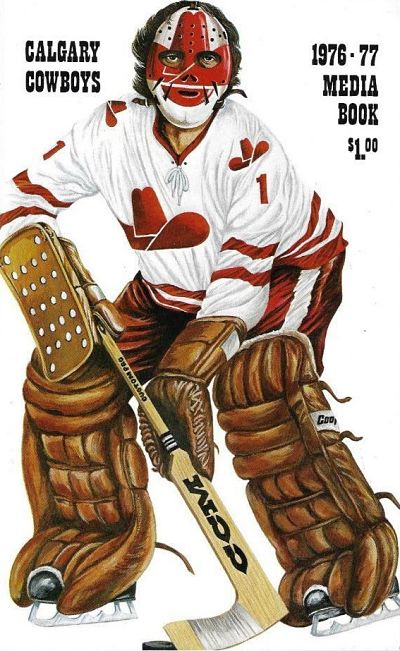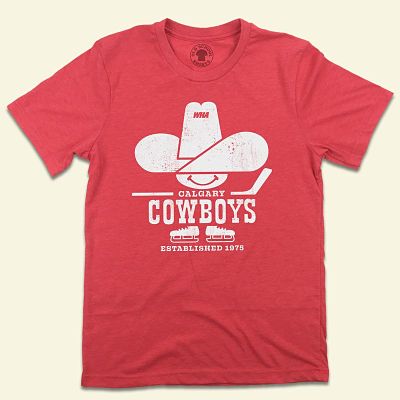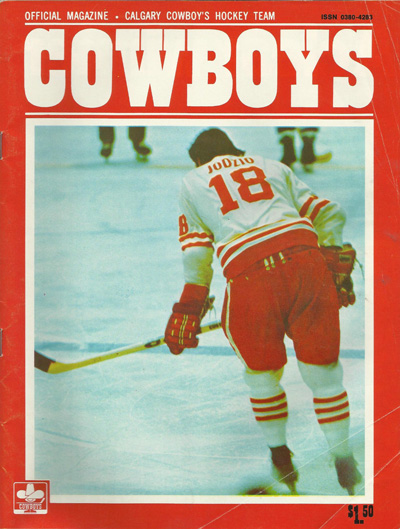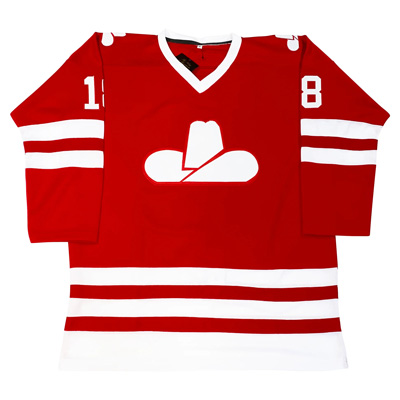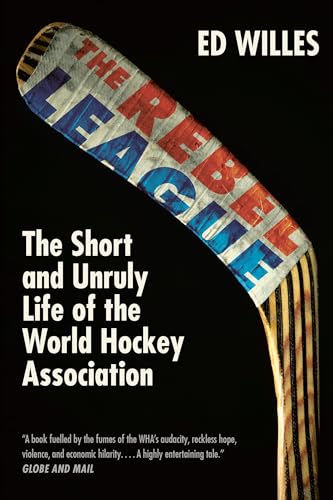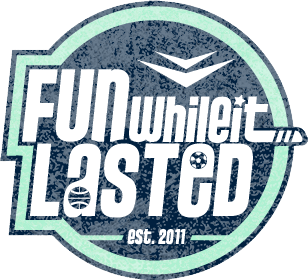World Hockey Association (1975-1977)
Tombstone
Born: May 7, 1975 – The Vancouver Blazers relocate to Calgary, Alberta
Folded: August 18, 1977
First Game: October 12, 1975 (L 2-0 vs. Minnesota Fighting Saints)
Last Game: April 7, 1977 (L 6-4 vs. Winnipeg Jets)
AVCO Cup Championships: None
Arena
Stampede Corral (6,445)11975-76 World Hockey Association Media Guide
Marketing
Team Colors: Red & White21975-76 World Hockey Association Media Guide
Ownership
Owner: Jim Pattison
Our Favorite Stuff
Calgary Cowboys WHA
Logo T-Shirt
The Cowboys were Calgary’s short-lived Major League precursor to the arrival of the Flames in 1980. The World Hockey Association lasted just two seasons at the tiny Stampede Corral from 1975 to 1977 and are best remembered today for a violent 1976 playoff brawl against the Quebec Nordiques.
This Cowboys design is also available as a Hooded or Crewneck Sweatshirt right now at Old School Shirts!
When you make a purchase through an affiliate link like this one, Fun While It Lasted earns a commission at no additional cost to you. Thanks for your support!
Background
Calgary, Alberta was the final destination for this nomadic pro hockey outfit. The franchise that would become the Calgary Cowboys formed in 1971 as the Miami Screaming Eagles of the start-up World Hockey Association. The team never got off the ground in Florida, moving instead to Pennsylvania as the Philadelphia Blazers for the WHA’s debut season during the winter of 1972-73.
In Philly, the Blazers persuaded Boston Bruins star Derek Sanderson to jump from the NHL with the largest contract in pro sports history at that time, $2.6 million over 5 seasons. Sanderson lasted less than a year in Philly and so did the Blazers. Vancouver entrepreneur Jim Pattison purchased the club in 1974 and moved the team to British Columbia to compete head-to-head with the NHL’s Vancouver Canucks. Failing to dislodge the Canucks from the top of the heap in Vancouver, Pattison moved his club to Calgary in May 1975, setting up shop at the city’s tiny 6,500-seat Stampede Corral.
First Season & Brawl with Quebec Nordiques
The Cowboys would last just two seasons in Calgary. The first season was a winning campaign (41-35-4) under Head Coach Joe Crozier that saw the team qualify for the playoffs. Danny Lawson led the 1975-76 squad in scoring with 44 goals and 52 assists.
The Cowboys are best remembered today for an infamous brawl with Quebec Nordiques on April 11, 1976. In Game 2 of the teams’ Avco Cup quarterfinal playoff series at Le Colisee in Quebec, Cowboys enforcer Rick Jodzio leveled Nordiques winger Marc Tardif with a devastating check that knocked the WHA’s leading scorer unconscious. No video appears to survive of the hit itself. The Nordiques say it was a cross check. Jodzio’s sympathizers suggest it was merely charging. What’s not in doubt is that the brutal impact sent the helmet-less Tardif flying and he smacked his head on the ice, losing consciousness. Jodzio then pounced on top of Tardif and punched the motionless star several times in the head. Both benches cleared for a near 30-minute riot, quelled only after 20 policemen swarmed the rink to restore order.
The Nordiques threatened to boycott the rest of the playoffs unless Jodzio was banned for life, Joe Crozier was suspended for the rest of the playoffs and WHA official Bud Poile resigned. Later that week Sports Illustrated quoted Nordiques President John Dacres on the Jodzio-Tardif incident:
“We pay some of our players up to $225,000 a year. We’re not going to have them chopped down by some stick-swinging maniac who earns $15,000.”
In the end, the Cowboys eliminated the favored Nordiques in five games. They lost to the eventual champion Winnipeg Jets in the 1976 Avco Cup semi-finals. Jodzio was not banned for life and, in fact, returned to play for the Cowboys in the second and final season in 1976-77. He did stand trial in Quebec on assault charges and paid a fine. Tardif missed the rest of the playoffs with a severe concussion and suffered headaches for years afterwards
Demise & Aftermath
Despite the Cowboys deep playoff run in the first season in Calgary, fan interest remained lukewarm heading into the 1976-77 season. Season ticket sales dropped from 2,900 in 1975-76 to approximately 2,300 in year two. The team’s on ice performance also dipped. The Cowboys finished next-to-last in the WHA’s Western Division at 31-43-7 and missed the playoffs.
With firm plans for a suitable arena to replace Stampede Corral on the horizon, Calgary was not an attractive candidate for the WHA on-again, off-again merger talks with the National Hockey League. In the spring of 1977, owner Jim Pattison stated the team would need to sell 4,400 season tickets to stay viable in the short term at the Stampede Corral. With sales stalled around half that number in August 1977, ownership folded the club.
The merger finally came to pass two years later. The WHA played its final campaign in the winter of 1978-79. Four WHA franchises – the Edmonton Oilers, New England Whalers, Quebec Nordiques and Winnipeg Jets – were accepted into the NHL for the 1979-80 season.
Major League hockey returned to Calgary in 1980 when the NHL’s Atlanta Flames relocated to the city. The Calgary Flames played three seasons at the Stampede Corral until the Saddledome opened in 1983.
Calgary Cowboys Shop
Our Favorite Gear
Calgary Cowboys
Replica Jersey
When it comes to Replica Jerseys, we turn to our friends at Royal Retros, who put extraordinary detail into their fully customizable hockey sweaters.
Free Customization Included
Each jersey individually handmade
Any name and number
Sewn tackle twill crest, numbers & letters
100% polyester
Heavyweight fabric made to game standards
Fight strap included
When you make a purchase through an affiliate link like this one, Fun While It Lasted earns a commission at no additional cost to you. Thanks for your support!
Editor's Pick
The Rebel League
The Short and Unruly Life of the World Hockey Association
By Ed Willes
The Rebel League celebrates the good, the bad, and the ugly of the fabled WHA. It is filled with hilarious anecdotes, behind the scenes dealing, and simply great hockey. The upstart WHA introduced to the world 27 new hockey franchises, a trail of bounced cheques, fractious lawsuits, and folded teams. It introduced the crackpots, goons, and crazies that are so well remembered as the league’s bizarre legacy.
But the hit-and-miss league was much more than a travelling circus of the weird and wonderful. It was the vanguard that drove hockey into the modern age. It ended the NHL’s monopoly, freed players from the reserve clause, ushered in the 18-year-old draft, moved the game into the Sun Belt, and put European players on the ice in numbers previously unimagined..
When you make a purchase through an affiliate link like this one, Fun While It Lasted earns a commission at no additional cost to you. Thanks for your support!
Links
###

